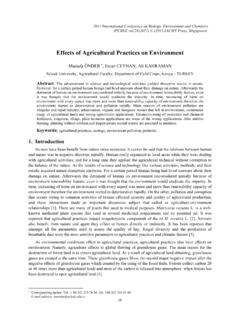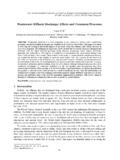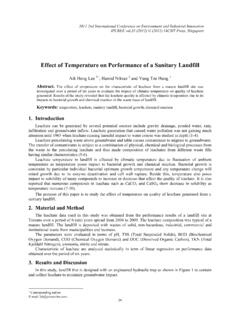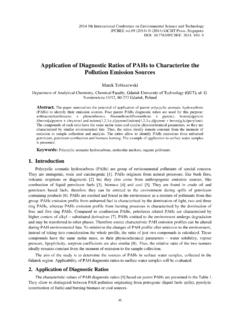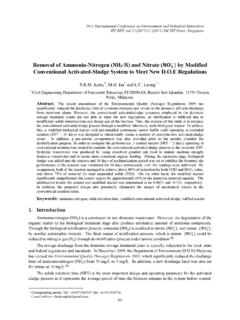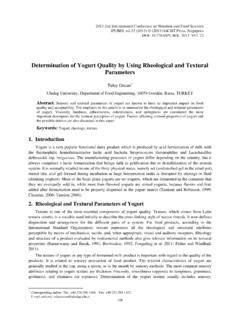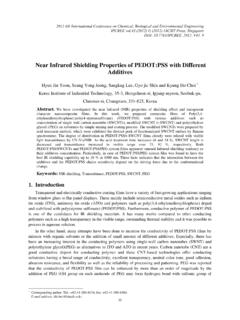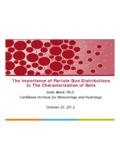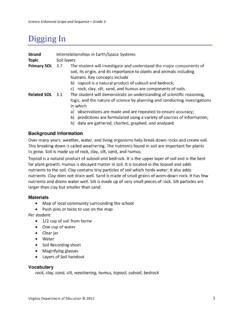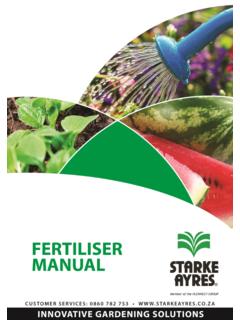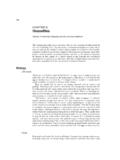Transcription of A Literature Review on the Composting - IPCBEE
1 A Literature Review on the Composting Saleh Ali Tweib , Rakmi Abd Rahman and Mohd Sahaid Kalil. Department of Chemical & Process Engineering, Faculty of Engineering & Built Environment, Universiti Kebangsaan Malaysia 43600 UKM Bangi Selangor Darul Ehsan MALAYSIA Telephone +60(3)89216419, Fax +60(3)89216148, e-mail Abstract. Composting has been used as a means of recycling organic matter back into the soil to improve soil structure and fertility. The Composting process has received much attention in recent years because of pollution concerns and the search for environmentally sound methods for treating waste. Waste volumes continue to rise, which leads to loss of resources and increased environmental risks. Open dumping and sanitary landfill is a major method for waste disposal, the Land filling of biodegradable waste is proven to contribute to environmental degradation, mainly through the production of highly polluting leachate and methane gas.
2 Composting aims to stabilization of waste for land filling , volume and mass reduction of solid waste and return of organic substances to the natural cycle .This paper reviews information on the Composting for treating waste as a means of addressing the environmental pollution concerns. Key words: Environmental pollution, solid waste and Composting . 1. Introduction Landfill and incineration have until now been the most widely used means of solid waste disposal throughout the world, the land filling of biodegradable waste is proven to contribute to environmental degradation, mainly through the production of highly polluting leachate and methane gas. Methane constitutes one of the six greenhouse gases responsible for the global warming, which needs to be reduced, in order to tackle climate change under the Kyoto Protocol (UN, 1998).
3 The methane emissions from landfills constitute about 30% of the global anthropogenic emissions of methane to the atmosphere (COM, 1996). The problems are like hundreds of tones of biodegradable organic waste are being generated in cities and towns in the countries and creating disposal problems. Such as every day, grocery stores discard perishable products such as fruits, vegetables, bread, pastries, milk products, fish, seafood and other frozen products. The concept of recycling waste nutrients and organic matter back to agricultural land is feasible and desirable. Land application represents a cost effective outlet for the producers of compostable wastes and a potential cheap source of organic matter and fertilizer elements for landowners. Composting is one of the most promising technologies to treat wastes in a more economical way, for many centuries Composting has been used as a means of recycling organic matter back into the soil to improve soil structure and fertility.
4 Composting is a natural process that turns organic material into a dark rich substance, this substance called compost is a wonderful conditioner for soil, during Composting microorganisms such as bacteria and fungi break down complex organic. Compounds into simpler substances and produce carbon dioxide, water, minerals and stabilized organic matter (compost). The process produces heat, which can destroy pathogens (disease causing microorganisms) and weed seeds. 2. Why Composting ? 1. Healthier plants. 3. Composting is practical and convenient. Saleh Ali 124 2011 International Conference on Environment and Industrial Innovation IPCBEE (2011) (2011)IACSIT Press, Singapore 2. Composting saves your money.
5 4. Composting is a good alternative to land filling. 3. Compost application to agricultural soil Composting helps to optimise nutrient management and the land application of compost may contribute to combat soil organic matter decline and soil erosion (Van Camp et al, 2004). Compost land application completes a circle whereby nutrients and organic matter which have been removed in the harvested produce are replaced (Diener et al ,1993).The recycling of compost to land is considered as a way of maintaining or restoring the quality of soils, mainly because of the fertilizing or improving properties of the organic matter contained in them. Furthermore, it may contribute to the carbon sequestration and may partially replace peat and fertilizers (Smith et al, 2001).Compost application to agricultural land needs to be carried out in a manner that ensures sustainable development.
6 Management systems have to be developed to enable to maximize agronomics benefit, whilst ensuring the protection of environmental quality. The main determinant for efficient agronomics use is nitrogen availability, high nitrogen utilization in agriculture from mineral fertilizers is well established and understood, whereas increasing the nitrogen use efficiency of organic fertilizers requires further investigation (Amlinger et al, 2003). 4. The Composting process Composting of agricultural waste and municipal solid waste has a long history and is commonly employed to recycle organic matter back into the soil to maintain soil fertility. The recent increased interest in Composting however has arisen because of the need for environmentally sound waste treatment technologies.
7 Composting is seen as an environmentally acceptable method of waste treatment (Yvette B etal, 2000). It is an aerobic biological process which uses naturally occurring microorganisms to convert biodegradable organic matter into a humus like product. The process destroys pathogens, converts N from un stable ammonia to stable organic forms, reduces the volume of waste and improves the nature of the waste. It also makes waste easier to handle and transport and often allows for higher application rates because of the more stable, slow release, nature of the N in compost (Fauziah etal, 2009). The effectiveness of the Composting process is influenced by factors such as temperature, oxygen supply ( aeration) and moisture content. There are two fundamental types of Composting aerobic and anaerobic: Aerobic Composting is the decomposition of organic wastes in the presence of oxygen (air); products from this process include CO2, NH3, water and heat.
8 This can be used to treat any type of organic waste but, effective Composting requires the right blend of ingredients and conditions. These include moisture contents of around 60-70% and carbon to nitrogen ratios (C/N) of 30/1. Any significant variation inhibits the degradation process. Generally wood and paper provide a significant source of carbon while sewage sludge and food waste provide nitrogen. To ensure an adequate supply of oxygen throughout, ventilation of the waste, either forced or passive is essential. (Yvette B etal, 2000). Anaerobic Composting is the decomposition of organic wastes in the absence of O2, the products being methane (CH4), CO2, NH3 and trace amounts of other gases and organic acids. Anaerobic Composting was traditionally used to compost animal manure and human sewage sludge, but recently is has become more common for some municipal solid waste (MSW) and green waste to be treated in this way (Yvette B etal, 2000).
9 5. Phases of Composting 1. Mesophilic phase (I). 3. Cooling phase (III). 2. Thermophilic phase (II). 4. Maturing phase (IV). (Yvette ). 6. Important Parameters of Composting process 125 1. Water content. 3. Nutrients. 5. PH. 2. Oxygen Demand. 4. Temperature. 6. Time. (Romeela Mohee, 2005). 7. Suitable materials for Composting Can be composted Cannot be composted Sewage sludges Coal ash. Industrial wastes ( food, pulp & paper). Metal, glass and plastic. Yard and garden wastes. Nappies. Municipal solid wastes (up to 70% organic matter by weight). The roots of persistent weeds, like bindweed and couch grass. Soft prunings, clippings and leaves Leaves with persistent disease such asblackspot. Kitchen waste like fruit, peelings, teabag sand egg shell.
10 Meat or fish. Paper shredded, mixed with grass cuttings and used sparingly. Cooked food, especially meat, as this attracts vermin. Source: (Diener etal, 1993). 8. Methods of Composting 1. Static pile. 3. In-vessel. 5. Bin Composter. 2. Windrow. 4. Vermicomposting. (Fauziah , 2009) 9. Trouble shooting guide Problem Possible cause Solution Foul odor. Compaction. Turn or decrease its size. Excess moisture. Turn organic waste or add dry material such as straw. Ammonia odor. Too much nitrogen. Add high-carbon (brown) items Low temp. Too little moisture. Add water and turn Poor aeration. Turn Site Composting too small.
